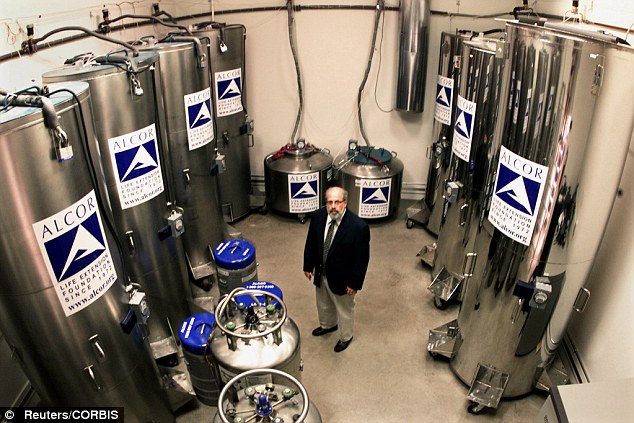


In the heat of Scottsdale, Arizona, time and death are "on pause" for nearly 200 humans cryopreserved in tanks filled with liquid nitrogen. The Alcor Life Extension Foundation, a non-profit, offers cryonic preservation services, freezing deceased individuals at extremely low temperatures in hopes of reviving them in the future. Despite claims of being the world leader in cryonics, the process, which costs hundreds of thousands of dollars, is met with skepticism and ethical concerns. The company's goal is for technology to one day catch up and bring back the "patients" as they were before their death - a controversial concept that has both fascinated and frightened the public.
Live After Death: The Fascinating and Controversial World of Cryonics
Introduction
In the heart of Scottsdale, Arizona, lies a place where time and death are paused for nearly 200 humans. These individuals, cryopreserved in tanks filled with liquid nitrogen, are the patients of the Alcor Life Extension Foundation, a non-profit organization that offers cryonic preservation services.
Cryonics, the process of freezing deceased individuals at extremely low temperatures in the hope of reviving them in the future, is a controversial concept that has both fascinated and frightened the public. Despite claims of being the world leader in this field, Alcor's work is met with skepticism and ethical concerns.
Background
The idea of cryonics originated in the 1960s, when scientists began to speculate that it might be possible to preserve human bodies and brains at temperatures so low that all biological processes would cease. In theory, these bodies could be revived in the future if advances in medical technology made it possible to repair any damage caused by the freezing process.
The first human to be cryopreserved was Dr. James Bedford, a psychology professor who died in 1967. Since then, hundreds of other people have chosen to undergo cryonic preservation, including Robert Ettinger, the founder of the Cryonics Institute, and Ted Williams, the legendary baseball player.
The Cryonic Process
The cryonic preservation process involves several steps:
Scientific and Ethical Concerns
While cryonics is based on sound scientific principles, it is still a highly experimental procedure. There is no guarantee that cryopreserved individuals can be revived in the future, and the long-term effects of freezing on the human body are not fully known.
There are also significant ethical concerns about cryonics. Some critics argue that it is disrespectful of the dead and that it gives false hope to people who are afraid of dying. Others question the wisdom of spending vast sums of money on cryonic preservation when there are so many other pressing human needs.
Top 5 FAQs
1. What are the costs of cryonic preservation?
The cost of cryonic preservation varies depending on the organization and the type of services requested. Alcor Life Extension Foundation offers a basic package for $200,000, which includes transportation to the facility, cooling, perfusion, and storage for 100 years.
2. What are the chances of being revived in the future?
This is impossible to say with certainty. Cryonics is still an experimental procedure, and there is no guarantee that it will be successful. However, Alcor believes that the chances of revival are good, provided that the cryopreserved individual is in good health at the time of death and that the cryonic process is performed correctly.
3. What are the ethical concerns about cryonics?
Critics of cryonics argue that it is disrespectful of the dead and that it gives false hope to people who are afraid of dying. Others question the wisdom of spending vast sums of money on cryonic preservation when there are so many other pressing human needs.
4. What are the scientific challenges facing cryonics?
The main scientific challenges facing cryonics are the prevention of ice crystal formation and the repair of damage caused by the freezing process. Ice crystals can damage cells and tissues, and the freezing process can also cause damage to proteins and lipids.
5. What is the future of cryonics?
The future of cryonics is uncertain. It is possible that advances in medical technology will make it possible to revive cryopreserved individuals in the future. However, it is also possible that cryonics will never be successful. Only time will tell.

A remote monitoring camera operated by the US Geological Survey captured stunning visuals of the recent volcanic eruption at Hawaii's Kilauea Volcano. The footage showed lava fountains up to 100 feet high and the raw power of nature as the lava eventually engulfed the camera. This eruption, known as Episode 38, was the latest in a series of eruptions that have been occurring since December last year. However, according to USGS, another episode could take place in the near future.

Indian Prime Minister Narendra Modi virtually inaugurated Skyroot Aerospace's new Infinity Campus in Hyderabad and unveiled their first orbital launch vehicle, the Vikram-I. During the event, PM Modi praised India's advancements in space technology and spoke about the importance of private companies like Skyroot in driving innovation in the space sector. The Infinity Campus, equipped with state-of-the-art facilities, has the capacity to produce one rocket per month, marking a significant milestone in India's private space manufacturing capability. Skyroot Aerospace, founded by former ISRO engineers, has quickly become a prominent player in India's growing space industry, with the successful launch of Vikram-S, the country's first privately built sub-orbital rocket.

We all experience changes in our mood, whether it's feeling happy and content or irritated and moody. But what are the underlying factors that contribute to these changes? This article from Medindia explores the top 10 things that can affect our mood, from physical health to environmental factors. It also provides tips on how to avoid these mood-altering triggers and maintain a positive state of mind. With a focus on promoting overall well-being, Medindia's policies align with the UN's Sustainable Development Goals, making it a reliable source of information for health and wellness.

A recent report by Public Health Scotland has shown a steep increase in flu cases and hospitalizations in Scotland. The numbers have more than doubled from the previous week, with a higher intensity observed in younger age groups. Experts are warning of a long flu season and a new variant of the illness that is spreading more easily. Health Secretary Neil Gray has assured the public that there are enough doses of flu vaccine available in the country.

The observation of National Pollution Control Day on 2 December serves as a timely reminder of India's struggle with escalating pollution levels. The recent years have seen a sharp increase in toxic particles and hazardous emissions, causing severe health issues and environmental damage. The ongoing pollution emergency calls for more stringent regulations, better urban planning, and increased public engagement to mitigate the crisis.

As World AIDS Day approaches, conversations around HIV prevention in India are becoming more open and informed. In particular, there is growing interest in PrEP (pre-exposure prophylaxis), a medicine that offers strong protection against HIV when used correctly. With rising awareness and more accessible sexual-health services, doctors are seeing a steady rise in patients asking about PrEP as a proactive health choice. This signals a shift towards informed prevention and a stigma-free dialogue surrounding HIV.

ISRO has been making continuous efforts to establish contact with the Vikram lander and Pragyan rover, which were put into sleep mode earlier this month, ahead of the lunar night. However, the prolonged spell of cold weather conditions, reaching up to -150 degrees Celsius, has made it difficult for them to wake up. With the sunrise on the Moon's south polar region and their solar panels believed to be optimally charged now, ISRO is hoping to revive the lander and rover and continue with their experiments and studies. The latest update from ISRO is that the plan to reactivate them has been delayed to September 23 due to the extreme lunar weather conditions.

Monsoon season may bring romantic vibes, but it's also a nightmare for contact lens wearers. Rainwater contains bacteria and pollutants that can cause eye infections, especially when wearing contact lenses. Ophthalmologists recommend using glasses instead and practicing good hygiene to avoid irritation and infection.

India's first human spaceflight mission, Gaganyaan, is one step closer to reality as ISRO successfully tested the main parachutes for the mission's Crew Module. The test, conducted at the Babina Field Firing Range in Uttar Pradesh, is part of the qualification process for the Gaganyaan parachute system. The system, which includes 10 parachutes of different types, is designed to ensure the safe and stable descent of astronauts returning to Earth. This milestone test marks a crucial step forward for India's ambitious space exploration goals.

As World Pneumonia Day is observed on November 12, experts are drawing attention to the dangerous link between air pollution and respiratory illnesses. In India, the post-Diwali smog adds to the already high levels of pollution, increasing the risk of pneumonia, particularly among vulnerable populations. While outdoor air pollution is often blamed, experts emphasize that poor indoor air quality also plays a significant role in triggering and worsening respiratory infections. Health professionals are urging for better air quality regulations and precautions to prevent this deadly connection between pollution and pneumonia.